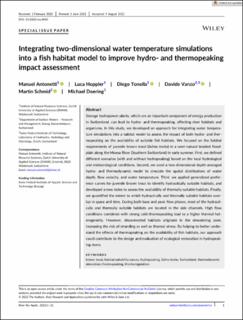Please use this identifier to cite or link to this item:
https://doi.org/10.21256/zhaw-25595| Publication type: | Article in scientific journal |
| Type of review: | Peer review (publication) |
| Title: | Integrating two‐dimensional water temperature simulations into a fish habitat model to improve hydro‐ and thermopeaking impact assessment |
| Authors: | Antonetti, Manuel Hoppler, Luca Tonolla, Diego Vanzo, Davide Schmid, Martin Doering, Michael |
| et. al: | No |
| DOI: | 10.1002/rra.4043 10.21256/zhaw-25595 |
| Published in: | River Research and Applications |
| Volume(Issue): | 39 |
| Issue: | 3 |
| Page(s): | 501 |
| Pages to: | 521 |
| Issue Date: | 30-Aug-2022 |
| Publisher / Ed. Institution: | Wiley |
| ISSN: | 1535-1459 1535-1467 |
| Language: | English |
| Subjects: | Brown trout; Habitat suitability curve; Hydropeaking; Salmo trutta; Switzerland; Thermodynamic simulation; Thermopeaking; Thermoregulation |
| Subject (DDC): | 639.8: Aquaculture |
| Abstract: | Storage hydropower plants, which are an important component of energy production in Switzerland, can lead to hydro- and thermopeaking, affecting river habitats and organisms. In this study, we developed an approach for integrating water temperature simulations into a habitat model to assess the impact of both hydro- and thermopeaking on the availability of suitable fish habitats. We focused on the habitat requirements of juvenile brown trout (Salmo trutta) in a semi-natural braided floodplain along the Moesa River (Southern Switzerland) in early summer. First, we defined different scenarios (with and without hydropeaking) based on the local hydrological and meteorological conditions. Second, we used a two-dimensional depth-averaged hydro- and thermodynamic model to simulate the spatial distributions of water depth, flow velocity, and water temperature. Third, we applied generalized preference curves for juvenile brown trout to identify hydraulically suitable habitats, and developed a new index to assess the availability of thermally suitable habitats. Finally, we quantified the extent to which hydraulically and thermally suitable habitats overlap in space and time. During both base and peak flow phases, most of the hydraulically and thermally suitable habitats are located in the side channels. High flow conditions combined with strong cold-thermopeaking lead to a higher thermal heterogeneity. However, disconnected habitats originate in the dewatering zone, increasing the risk of stranding as well as thermal stress. By helping to better understand the effects of thermopeaking on the availability of fish habitats, our approach could contribute to the design and evaluation of ecological restoration in hydropeaking rivers. |
| URI: | https://digitalcollection.zhaw.ch/handle/11475/25595 |
| Fulltext version: | Published version |
| License (according to publishing contract): | CC BY-NC-ND 4.0: Attribution - Non commercial - No derivatives 4.0 International |
| Departement: | Life Sciences and Facility Management |
| Organisational Unit: | Institute of Natural Resource Sciences (IUNR) |
| Appears in collections: | Publikationen Life Sciences und Facility Management |
Files in This Item:
| File | Description | Size | Format | |
|---|---|---|---|---|
| 2022_Antonetti-etal_Integrating-two‐dimensional-water-temperature-simulations-fish-habitat.pdf | 4.37 MB | Adobe PDF |  View/Open |
Show full item record
Antonetti, M., Hoppler, L., Tonolla, D., Vanzo, D., Schmid, M., & Doering, M. (2022). Integrating two‐dimensional water temperature simulations into a fish habitat model to improve hydro‐ and thermopeaking impact assessment. River Research and Applications, 39(3), 501–521. https://doi.org/10.1002/rra.4043
Antonetti, M. et al. (2022) ‘Integrating two‐dimensional water temperature simulations into a fish habitat model to improve hydro‐ and thermopeaking impact assessment’, River Research and Applications, 39(3), pp. 501–521. Available at: https://doi.org/10.1002/rra.4043.
M. Antonetti, L. Hoppler, D. Tonolla, D. Vanzo, M. Schmid, and M. Doering, “Integrating two‐dimensional water temperature simulations into a fish habitat model to improve hydro‐ and thermopeaking impact assessment,” River Research and Applications, vol. 39, no. 3, pp. 501–521, Aug. 2022, doi: 10.1002/rra.4043.
ANTONETTI, Manuel, Luca HOPPLER, Diego TONOLLA, Davide VANZO, Martin SCHMID und Michael DOERING, 2022. Integrating two‐dimensional water temperature simulations into a fish habitat model to improve hydro‐ and thermopeaking impact assessment. River Research and Applications. 30 August 2022. Bd. 39, Nr. 3, S. 501–521. DOI 10.1002/rra.4043
Antonetti, Manuel, Luca Hoppler, Diego Tonolla, Davide Vanzo, Martin Schmid, and Michael Doering. 2022. “Integrating Two‐Dimensional Water Temperature Simulations into a Fish Habitat Model to Improve Hydro‐ and Thermopeaking Impact Assessment.” River Research and Applications 39 (3): 501–21. https://doi.org/10.1002/rra.4043.
Antonetti, Manuel, et al. “Integrating Two‐Dimensional Water Temperature Simulations into a Fish Habitat Model to Improve Hydro‐ and Thermopeaking Impact Assessment.” River Research and Applications, vol. 39, no. 3, Aug. 2022, pp. 501–21, https://doi.org/10.1002/rra.4043.
Items in DSpace are protected by copyright, with all rights reserved, unless otherwise indicated.